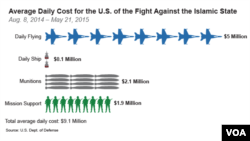U.S. officials have used many words to describe the terror group known as Islamic State, including "brutal," "nimble" and "resilient."
As the United States approaches the one-year anniversary of the start of airstrikes against Islamic State, officials may also need to add the word "costly."
According to numbers released this week by the Defense Department, the U.S. has spent $2.74 billion on counter-IS operations between August 8, 2014, and June 4, 2015, for an average of $9.1 million a day.
The U.S. Air Force has incurred the vast majority of the cost, 67 percent, followed by the Navy at 16 percent.
More than half of the cost, about $1.5 billion, has gone toward keeping U.S. planes in the air, with another $646 million going toward munitions.
The Pentagon considers it money well spent, noting Islamic State has been rolled back from 25 percent of the territory it once held and that key cities and towns, like Tikrit, Sinjar, Amerli and Kobani, have been taken back with the help of U.S. air support.
“We have disrupted much of their [Islamic State’s] command and control,” said spokesman Colonel Steve Warren. “We have significantly eroded their ability to generate revenue.”
“All of this demonstrates that what we’ve been doing has been successful,” he said.
Still, a closer look at the numbers has some concerned.
'Mission creep'
“I think there will continue to be a gradual growth in the daily cost, because we are in the midst of what is called mission creep,” said Loren Thompson, a defense analyst with the Lexington Institute. “It’s awfully hard to say whether the money is being well spent without a clear articulation by the Obama administration as to what its goals are.”
According to the Pentagon’s own numbers, the average daily cost at the start of the U.S. air campaign was $5.6 million. But since President Barack Obama decided to expand the air campaign into Syria, the average daily cost of counter-IS operations has been $9.7 million.
Not all of the costs associated with the U.S. effort to degrade and ultimately destroy the Islamic State are reflected in the latest Pentagon numbers. For example, the figures do not include the cost of the administration’s $1.6 billion train-and-equip program for Iraqi forces.
Nor do the numbers reflect the cost of preparing and then operating the Taqaddum Air Base in Anbar province, which will be the base of operations for 450 U.S. military personnel tasked with advising Iraqi forces to help improve their “operational planning and execution.”
“Little by little, that range of activities and the number of participants is growing,” Thompson said.
No more bases planned
U.S. Central Command said Friday that there were no plans for more bases like the one soon to be established at Taqaddum, but it refused to rule out the possibility that could change.
“We’re always looking at ways we could best support them [the Iraqis],” said CENTCOM spokesman Colonel Pat Ryder. “Naturally, this could include additional venues going forward if requested by the Iraqis and our senior leaders assess that it makes good operational sense.”
Despite the expansion of U.S. operations in Iraq, U.S. defense officials reject the notion of any “mission creep.”
“This is a continuation of the mission we declared from day one,” Warren said, calling the strategy of using air power and support for Iraqi ground forces to ultimately defeat the Islamic State “crystal clear.”
Defense officials have said repeatedly that they expect it will take at least three years to destroy the Islamic State group. If the average cost of counter-IS operations stays the same, the price tag at the end of three years will be just shy of $10 billion.










